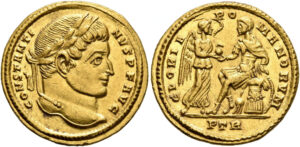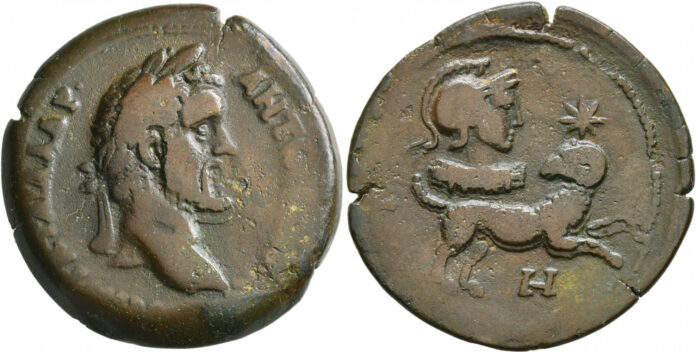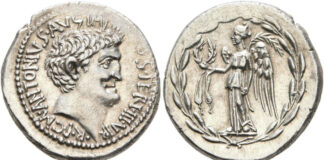The Rhakotis Collection of Coins From Alexandria
No fewer than 5,150 lots will be offered in Leu’s Web Auction 16 on 22-24 May 2021. The sale includes the Birger Bentsen Collection of ancient gold coins, further selections from the Dr. P. Vogl Collection, the collection of J. Knudsen, Hamburg, a collection of lead tesserae from Asia Minor, and many other interesting pieces.
A special highlight is the offering of the Rhakotis Collection, an impressive assemblage of Ptolemaic and Roman Alexandrian coins formed in the 1960s and 1970s. ‘Rhakotis’ means ‘construction site’ in Ancient Egyptian, a rather prosaic indigenous name for the newly founded Greek city of Alexandria. Though Alexander foresaw that Alexandria would prosper due to its advantageous location, nestled between Lake Mareotis and the Mediterranean, he could scarcely have imagined that it would become one of the largest and wealthiest cities of the ancient world. This affluence is reflected in the city’s coinage, first under the Ptolemies, after 30 BC under the Romans, forming a lasting monument to Alexandria’s cultural achievements.

The current selection of coins is remarkable for several reasons. First of all, the 3rd-century Ptolemaic bronze coinage represented in the Rhakotis Collection shows a dazzling variety of mint marks, controls and denominations, ranging from the humble dichalkon to the impressive octobol. The silver tetradrachms, on the other hand, include many dated issues, such as those of Ptolemy II struck at Tyre, Gaza and Ioppe, and those of the later Ptolemies struck at Alexandria proper. Here, the focus of the collector was clearly aimed at gathering as many different regnal years as possible.
As for the Roman coins, the sheer variety of the designs will delight anyone with an interest in Egyptian history. While the Ptolemies were relatively conservative in their typology, under the Romans we soon see a great blossoming of different designs, which reached its zenith under the Five Good Emperors. Since the Alexandrian coinage was intended to circulate in the whole of Egypt, the reverse types, though Greek in outlook, often draw their inspiration from Egyptian culture and religion. Next to the variety in types, collectors of the Alexandrian series will be excited by the opportunity to add many exceedingly rare pieces to their collections, with often only a handful of other examples known and even a few pieces unpublished in the major catalogues.
The Julio-Claudian coinage includes a few of the earliest pieces struck in Egypt under Augustus, which are firmly rooted in the numismatic heritage of Cleopatra. The Egyptian experience with strong women perhaps inspired the mint to quickly start producing pieces in the name of Livia (lot 1936). Indeed, one of the most remarkable features of the Alexandrian coinage is the depiction of empresses only seldomly shown (or not at all) on the imperial coinage, such as Messalina under Claudius or Octavia and Poppaea under Nero. Under Tiberius, the production of billon coins was (re)introduced, with lot 1937 forming a particularly fine example with Tiberius on the obverse and Divus Augustus on the reverse. The coins of Nero are noteworthy for the inclusion of many types that are rare for the regnal years in which they were struck.
Nero committed suicide in 68, plunging the Roman world into a short, but brutal civil war. All four emperors of the civil war of 69 are represented on the Alexandrian coinage, though the coins of Vitellius are generally scarcer than those of his rivals (lots 2039-2040). An interesting feature of the Flavian coinage is the dynastic ‘propaganda’ of Vespasian, who had the good fortune of having two adult sons, a great advantage in the bid for the throne, as this ensured a smooth succession. Only Titus was granted the honor of appearing on the coins with his father, however, perhaps not least because he was well known in the East due to his successes in Judaea. We should also mention the impressive drachm showing Domitian in a biga pulled by two centaurs (lot 2066), extremely rare for the regnal year in which it was struck.
Turning to the Nerva-Antonine period, we enter the golden age of the Roman Alexandrian coinage. Starting from Trajan, there is a great variation in bust types, legends and reverse types. The large size of the bronze drachm in particular left ample space for the die-cutters to show their skill in engraving increasingly complex designs. Fine examples of this are the drachms of Antoninus Pius showing Isis Euploia amidst ships and other deities (lots 2381-2382) or the extremely rare piece showing Serapis on a galley with Demeter and Tyche in reference to the Eleusinian Mysteries (lot 2393). Architectural types are also abundant in this period. The Pharos of Alexandria, one of the seven wonders of the ancient world, was particularly popular (lots 2178, 2197-2199, 2278-2279, 2331-2337, 2363, 2409-2410), but we also find triumphal arches (lot 2127), pylons of Egyptian temples (lot 2238) and even a reference to a construction of Hadrian connected to the Serapeum of Alexandria (lot 2181-2182).


No collection of Alexandrian coins would be complete without coins from two of the most impressive series of bronze drachms produced in Egypt, namely those showing the labors of Herakles and the Zodiac coins, both struck under Antoninus Pius. The first series is represented in this sale by two very rare pieces, one depicting the capture of the Erymanthian boar and the cowardly Eurystheus hiding in a jar (lot 2288), and another showing Herakles’ creative solution to the cleaning of the Augean Stables (lot 2318). As for the Zodiac coins, which were probably struck in celebration of the marriage of Marcus Aurelius and Faustina the Younger, special mention must be made of lot 2301, no fewer than six examples are represented in the Rhakotis Collection (lots 2300-2305).
Another highlight of the Nerva-Antonine period are the so-called nome coins, which honor the various nomes (‘districts’) of Egypt and provide a fascinating glimpse into local religious life. For instance, the obols struck under Hadrian for the Arsinoites show Amenemhat III (lots 2136-2137), an Egyptian pharaoh of the 12th Dynasty (circa 1831-1786 BCE), who is the earliest historical figure to be depicted on an ancient coin. For the Apollonopolite nome, which houses the impressive temple of Horus in Edfu, we see Apollo as Horus holding a falcon on a drachm of Antoninus Pius (lot 2311). We are also excited to mention the drachm of the same emperor struck for the Sebennyte nome, showing the warrior-god Ares-Anhur, which is exceptionally well preserved for the type (lot 2308).
Turning to the third century, though Egypt was not spared of the general economic weakening on the Empire, its coins manage to impress us with a quality of engraving that regularly surpasses that of the contemporaneous imperial coinage. This is especially noticeable in the coinage of Gallienus, with lots 2498 and 2502 showing two particularly dignified portraits. The tetrarchic period, which saw the final output of provincial coins in Egypt, is represented by many extremely rare examples struck for all four emperors. Also included is a very attractive tetradrachm of the enigmatic usurper Domitius Domitianus (lot 2638).

Finally, we are glad to offer an interesting selection of lead tesserae (lots 2639-2717). These fascinating objects, though poorly studied, probably served different functions, ranging from locally produced small change to festival tokens. The designs are often inspired by the “official coinage”, the most impressive example being a tessera (lot 2717) copying the Judgement of Paris from the very rare drachms of Antoninus Pius. At other times we see completely original designs, such as lot 2683, which appears to show a farmer at work carrying a basket on his back, while another figure is holding his right foot. One relatively cohesive group are the tesserae depicting Antinoüs, the favorite of Hadrian, who drowned in the Nile during the emperor’s visit to Egypt in 130. He is often syncretized with Hermes (e.g. lot 2654) or Osiris (e.g. lot 2664), and in terms of style, the quality of his portraits sometimes nearly rival that of the Alexandrian coins (lot 2650). A second distinct group are the tesserae connected to the middle-Egyptian town of Oxyrhynchos (lots 2676-2680), well-known through the many papyri found there. These tokens show the Egyptian Taweret, protectress of Oxyrhynchos, in the guise of the Greek Athena, thus forming an intriguing blend of Greek numismatic imagery and Egyptian religion.
A final word must be said on the order in which the Roman Alexandrian coins are presented, namely by year of issue, rather than by emperor. The great advantage of grouping the coins in this manner is that it better captures the underlying intent of the mint in its choice of what to place on the coins in a given year. In turn, this leads to a better understanding of the types, and allows us to appreciate the coins more fully in their appropriate context.
For the first time Web Auction 16 is divided into three parts and will be auctioned off on consecutive days.
- Part I, which includes the Birger Bentsen Collection, Celtic, Greek, Oriental Greek and Central Asian coins (lots 1-1781), closes on Saturday, 22 May 2021 from 10 am CEST.
- Part II, which includes the Rhakotis Collection, Roman Provincial coins and a collection of lead tesserae from Asia Minor (lots 1782-3292), closes on Sunday, 23 May 2021 from 10 am CEST.
- Part III, which includes the Roman Republican & Imperatorial, Roman Imperial, Byzantine, early Medieval & Islamic and World coins as well as weights, seals and group lots (lots 3293-5150) closes on Monday, 24 May 2021 from 10 am CEST.
All lots of Leu Numismatik’s Web Auction 16 can be viewed on the website of Leu Numismatik as well as on Biddr and Sixbid.




